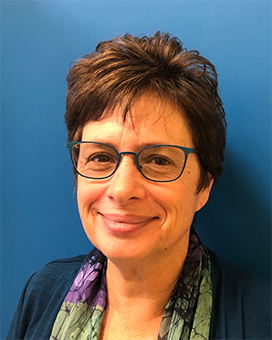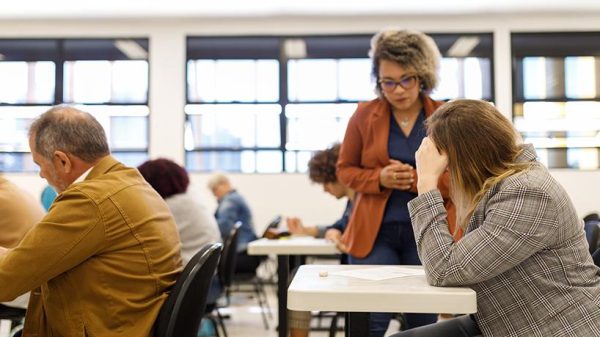By: Sarah Young
A white colleague recently asked me, “Sarah, why do we need culturally responsive coaching? Isn’t it just good coaching to be responsive to everyone?”
I had to give some thought to how I framed my response. The crux of the answer is, “No, it’s more complex than that,” as is the answer to the parallel question about serving diverse learners: “Isn’t it all just good teaching?” But I had to find the right words to explain this to my colleague and the others with whom I work as a culturally responsive coach.
It’s true that effective coaching is always responsive and based in listening deeply to each individual. However, what’s different for me as a culturally responsive coach is that I regularly set an intention to reflect on the role of social identity; the differences between myself, the teacher, or students; and the social political context in which the teacher is working. Before I open my mouth, I engage in self-talk: What do I think I know, and what might I be missing? How does my cultural lens give me insight, and how does it limit my understanding?
I want the teachers I support to learn about the diverse cultures and world-views of their students, examine unconscious biases, consider gaps in how they understand student behavior, make curriculum relevant and engaging, and raise rigor while cultivating a safe classroom environment. In a parallel process, I strive to model those same skills in working with the teacher.
Culturally responsive adult-to-adult relationships are foundational to forming school community where all adults and all students are able to thrive professionally, academically, and as whole beings. Share on XOften, the challenges teachers present to me are framed as neutral when they are, in fact, related to social context, culture, or race. Teachers often fail to recognize the assumptions that underlie comments like: “The curriculum is too hard for these students,” “The students are too noisy,” “They won’t do homework,” “They just don’t have skills based on their home life,” or “These parents don’t value education.”
In these situations, I push myself to move beyond color-blind or politically neutral coaching, to raise questions that help the teacher consider his or her perceptions of student behavior, engagement, or markers of intelligence and how those perceptions are influenced by identity and social location.
I’ll admit there are times I’m tempted to respond to teacher frustration or desperation by guiding them toward a quick-fix instructional solution. But this would be a disservice to the teachers and, more importantly, to students.
In a parallel process, I also ask myself about my own perceptions. I reflect on what I think I know about the teacher. I am a white, middle-aged, middle-class, Jewish woman. In what ways are my and the teachers’ identities similar or different? What might I need to learn more about the person I’m coaching? What do I know about my own triggers, and how they might surface in conversation?
As a white coach, how do I make it safe enough for teachers of color to share their struggles with me? How do I support white teachers to look beyond the lens of “whiteness” as they look at behavior and academic skills of racially diverse students and families?
''As a white coach, how do I make it safe enough for teachers of color to share their struggles with me?'' Share on XNaming identity
While I question myself about many kinds of differences between me and the adults I serve, race is the hardest and takes the most practice. For example, I recently prepared to observe Sally, a new, young, white teacher from a white suburban community working in racially diverse urban area.
Sally had asked me to collect data on a “certain group” of kids that often “call-out to disrupt the lesson.” I observed three African American boys who did regularly call-out without raising hands, yet my data showed the comments were relevant and on topic.
My first coaching step was to share the data and then model naming the influence of “whiteness” on my interpretations.
“As a white observer of students of color, I always ask myself what I think I know, and what I might be missing,” I said to Sally. “I know that having grown up in a segregated, white, middle-class community can affect my interpretations. I have a lot of influences that prime me to see loud, spontaneous behavior in kids of color as disruptive or threatening, where I might see the same behavior in white kids as merely exuberant. In this case, I have to ask myself, are the comments intending to disrupt, or could this be a learning strategy? The data I recorded shows the call-outs relate to what you’re teaching.”
Sally read over my notes and nodded thoughtfully. “Why are they calling out then?” she asks. “Why can’t they wait for me to call on them like the other students do?”
I responded: “It’s interesting. I’ve been reading and talking to other people who know more about different cultural learning styles than I do. From my own white perspective, I’m coming to understand how various nonwhite communities encourage a highly verbal learning style, where the audience is expected to interact out loud as they learn. I’m curious to see how the boys’ exuberance to respond might be channeled into a different sort of participation structure where call-outs are welcomed and encouraged, and you still feel in charge as a teacher.”
“What do you think that would look like?” Sally asked, looking perplexed, but still open. Now Sally and I had an entry point to a culturally responsive coaching conversation.
Radical humility
When I work with teachers of color, my self-talk questions are both similar and different from the ones I used with Sally. My starting place is radical humility, as I ask myself what I think I know and what I might be missing. Race is the topic I’ve been least prepared to talk about in my teacher training, coach training, or life experience.
One year I was assigned to coach Ted, an African American teacher about 20 years older than me. Ted related well to his students, but the curriculum he used in his alternative high school classes was built entirely around rote worksheets, which were not engaging the students or helping their comprehension.
Ted’s school was one where most students had been pushed out of mainstream settings. I felt some urgency to see them engaged with curriculum that supported critical thinking and drew on their rich life experiences.
As a teacher and professional learning leader for the California Writing Project, I figured I was just the right person to jump in and demonstrate to Ted how much more his students were capable of when they engaged in writing process lessons. Ted responded politely to my offering but was surprisingly distracted when I came in to model lessons, even though the kids were more engaged than I had seen them previously.
Ted then began to withdraw, missing our appointments and not following up on my gently offered suggestions for follow-up lessons. At one point, after I called him at home to reschedule a missed meeting, he got frustrated with me and asked to have me replaced as his coach.
I was confused — the request seemed abrupt. At the same time, I was relieved. I considered Ted to be a resistant teacher, or one who was just not up to doing the extra work involved in a more engaging curriculum.
However, my supervisor insisted I try to work it out with Ted, starting with an apology. Reluctantly, I agreed.
“Ted, I’m sorry I called you on a Sunday,” I said as I sat down at the desk across from him. “I didn’t understand. I’m used to teachers working on Sundays. Including me.”
“Do you want to understand?” he asked. His tone was calmer, and he looked at me directly. Did I want to understand? The question was uncomfortable. Had I come here to learn something or to defend myself?
“Yes,” I said, hesitating. “I may need help to understand.”
Ted chuckled. “True. You haven’t tried too hard.”
It became clear that he had a perception of me not trying too hard as a mentor. Ironically, that was how I had seen him as a teacher.
“I have a big life outside of this job, and Sundays are important to me.”
“Oh yes, you must have church on Sundays,” I replied.
“Don’t put me in a box, little lady. Black people don’t do any one thing the same. Do you want to ‘figure me out,’ or do you want to understand?”
“I do want to understand,” I said, uneasy that I still wasn’t getting it right. “I know someone like me might be missing a few things.” “Someone like me” was the closest I could come at that point to saying “white person.” I had not yet learned to use the muscle of naming whiteness. But I did want to make a bridge.
“On Sunday mornings, I do a radio show. It’s a mix of my faith, Baha’i, and my own experiences and spiritual path. On Sunday afternoon, I meet with other black Baha’is.”
“Really?” My undisguised astonishment was yet another flag of my white ignorance.
“I thought you’d be surprised. People often are. So I brought you something I wrote.” Ted handed me a pamphlet he had written about using principles of the Baha’i faith to reach out to black teenage boys.
“You’re a writer?” I stammered. “Why didn’t you mention that when I talked about teaching the kids writing?”
“You didn’t ask.”
“No, I guess I didn’t.”
Did Ted think I assumed he couldn’t have had professional writing experience because he is black? And, most difficult to ask myself, was it in any way true that that was my assumption? I hadn’t checked for his prior knowledge, even though that’s a basic practice in preparing teachers to use any new strategy. Had I even considered the possibility that he would know as much about writing as I did? Would I have asked different questions of a white person 20 years my senior?
I skimmed Ted’s pamphlet. It was thought-provoking, clearly organized, with a distinctive writer’s voice.
“Why didn’t you tell me about your writing skills?” I asked.
“You didn’t ask,” he repeated. “You just jumped right in like you knew it all.”
“That’s true. I thought you only knew how to teach from worksheets. Why did you use so many worksheets when you know so much about how to write?”
“I was trying to do well with what they gave me to use. That’s what I thought the job was.”
I wasn’t wrong about the need to move on from the worksheets, but I had been wrong about his motivation for using them. I had jumped in with the “best” way to teach without expressing curiosity about what Ted knew.
And I hadn’t considered that Ted viewed our interactions through the lens of his own life experience, in which he had frequently received the message that the “white way” of teaching was presumed to be best by the majority of white teachers, school leaders, and other authorities he had worked with and studied under, and the myriad books about education that are written by white authors.
I felt embarrassed, especially because, as a former bilingual teacher, I had worked with many students and families from backgrounds different from my own. Now I wondered: What else had I missed?
“Do you ever share any of your journalistic work with your students?” I asked.
“No.” Ted smiled and looked directly at me. “Do you think I should?” It was a genuine question.
I paused to take a breath. This was the first time in months of working with him that Ted had asked for my opinion on any teaching strategy. “Absolutely! I think the students would love it.”
Ted nodded and jotted down a few notes. I breathed out a deep sigh. It was only now that we had begun a culturally responsive conversation and could begin the work of mentoring.
Cultivating awareness
With both Ted and Sally, the process of culturally responsive coaching began not with inquiry-based coaching questions, but with engaging in an internal process of self-talk, reflection, humility, naming race and social identity, and cultivating genuine curiosity. When coaches and teachers cultivate our awareness, we are better positioned to identify the variety of strategies that will support diverse students with rigorous curriculum in a respectful, safe classroom environment.
Engaging in this process with one another allow us to model and reflect on how to engage in culturally responsive practice with students and families. Culturally responsive adult-to-adult relationships are foundational to forming school community where all adults and all students are able to thrive professionally, academically, and as whole beings.
Sarah Young works as a consultant supporting teacher effectiveness for educational equity. She works as a coach and workshop facilitator with a special focus on culturally responsive practice, coaching skills, and adult social and emotional learning. Sarah@sarahyoungconsulting.com









